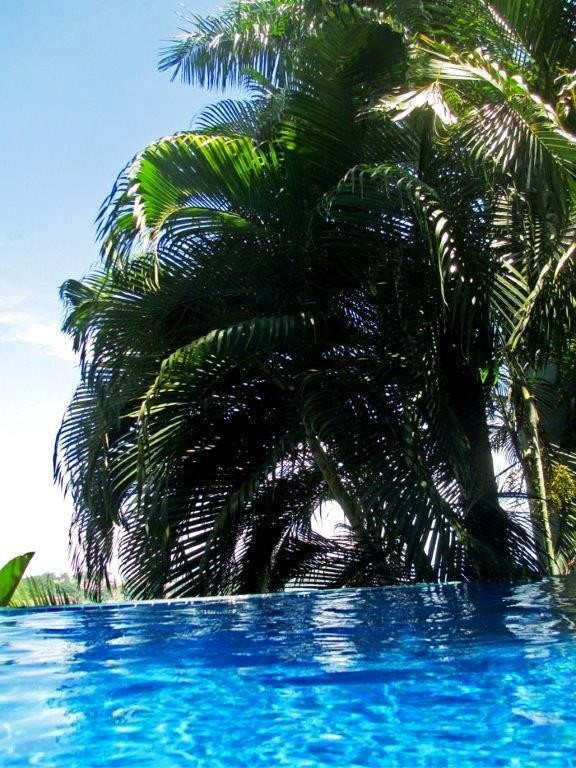By Tommy Clarkson from the September 2014 Edition

Butterfly Palm, Dypsis lutescens (Some call it Chrysalidocarpus lutescens)
Family: Arecea
(Also known as Yellow Butterfly Palm, Yellow Palm, Golden Butterfly, Cane Palm, Golden Cane Palm, Golden Yellow Palm, Golden Feather Palm, Madagascar Palm, and Yellow Bamboo Palm.)
Because it is so ubiquitous throughout the tropics and sub-tropics, the Butterfly Palm (around here often called the Areca Palm) is disdained by some palm purists. However, effectively filling an array of different roles, I like ‘em a lot!
Its Latin name means “growing yellow” a reference to its petioles (the stalk attaching the leaf blade to the stem.)
This fast growing, crown shafted, suckering (clustering or multiple trunked), palm comes from Madagascar though with a rather restricted domain in the wild, it is now considered endangered there. Its graceful arching, V-formed fronds are the source it being called, by many, a Butterfly Palm!
But like that brother-in-law we wish not to claim, it is often called by many other names! It has a wide enough diversity of designations already but, as a result of its family name, Arecea, this palm is regularly confused with even more – the twenty other, somewhat similar looking palms in that genus. (I enjoy hearing the different names visitors to Ola Brisa Gardens call them when touring our small, terraced, tropical paradise.)
It can be effectively used both indoors and outside. When used inside, keep it in a warm location avoiding placement in strong, direct sunlight. When properly planted – in full sun – outside, the good looking, silver-gray, bamboo-like (hence, another of its names Bamboo Palm), trunks and dense fronds of this palm can provide a lush backdrop, thwart the wind, diminish your neighbor’s loud music or provide a privacy screen so you can skinny dip in your pool!
It appreciates good, fertile, sandy, well draining soil and is quite drought tolerant. Dim light and low humidity are not this plant’s friend. If pruned very sparingly
(I keep 5-7 in a clump and remove only the suckers), watered regularly (but do not let its roots stand in water which will cause them to rot) and given soluble fertilizer every couple of months, it can grow to a height ranging from seven (23 feet) to twelve meters (39 ½ feet) meters. In maturity the trunks turn a more golden color – thus, yet another name by which it is known, Golden Cane Palm.
Its up to nearly three meters (10 feet), pinnate (feather shaped), medium green to bronze, leaves are compound, reduplicate and gracefully present themselves in a “V” form. Each of the 100 leaflets are four cm (1 ½ inches) to five cm (two inches) wide and about 1 1/2 inches wide. It can branch out to a width of nearly four meters (thirteen feet). Occasional browning of the tips is normal, so don’t worry.
It is a self-cleaner with fronds dropping when dried. (One may wish to anticipate this so as to preserve the integrity of plants growing beneath.)
Attractive to insects, the drooping, light yellow to gold, one meter (three feet) inflorescence is borne below the leaves. From pendent, branched clusters, small, yellowish white monoecious (male and female flowers on the same inflorescence) blossoms, small, oval yellow/orange/purple fruit come. Ours is off to the end side of our pool and, from it, I regularly enjoy watching the bees savor the flowers.
It develops a distinct golden coloration if starved of nutrients and regular watering or if in in very hot, sunny locales. This color is what often confuses folks into thinking it to be a different member of the Areca family. In fact, this species is, all too often, sold incorrectly as Areca lutescens,
While actually a rather hardy palm requiring minimal maintenance, some insect pests and diseases to which it is vulnerable include caterpillars, mealy bugs, banana moths, spider mites (generally when indoors), scales, sooty mold , gliocladium blight, ganoderma, phytophthora bud rot and graphiola flaw smut. . . . and, really now, who among us honestly likes smut!
I like the simplistically short, concise and direct way Robert Lee Riffle described this palm. “Few plants are as breathtakingly graceful as a well-grown clump of this palm.” In the proverbial nutshell he’s said it all!
A simply handsome plant, it is looks great on its own or as a landscape accent. But as it can grow to 7 ½ meters (25 feet) they can take up a bit of space – so plan, plant
and enjoy accordingly.


For back issues of “Roots”, gardening tips, tropical plant book reviews and videos of numerous, highly unique eco/adventure/nature tours, as well as memorable “Ultimate Experiences” such a Tropical Garden Brunches and Spa Services, visit us at.. www.olabrisagardens.com
Download the full edition or view it online
—
Tommy Clarkson is a bit of a renaissance man. He’s lived and worked in locales as disparate as the 1.2 square mile island of Kwajalein to war-torn Iraq, from aboard he and Patty’s boat berthed out of Sea Bright, NJ to Thailand, Germany, Hawaii and Viet Nam; He’s taught classes and courses on creative writing and mass communications from the elementary grades to graduate level; He’s spoken to a wide array of meetings, conferences and assemblages on topics as varied as Buddhism, strategic marketing and tropical plants; In the latter category he and Patty’s recently book, “The Civilized Jungle” – written for the lay gardener – has been heralded as “the best tropical plant book in the last ten years”; And, according to Trip Advisor, their spectacular tropical creation – Ola Brisa Gardens – is the “Number One Tour destination in Manzanillo”.





You must be logged in to post a comment.